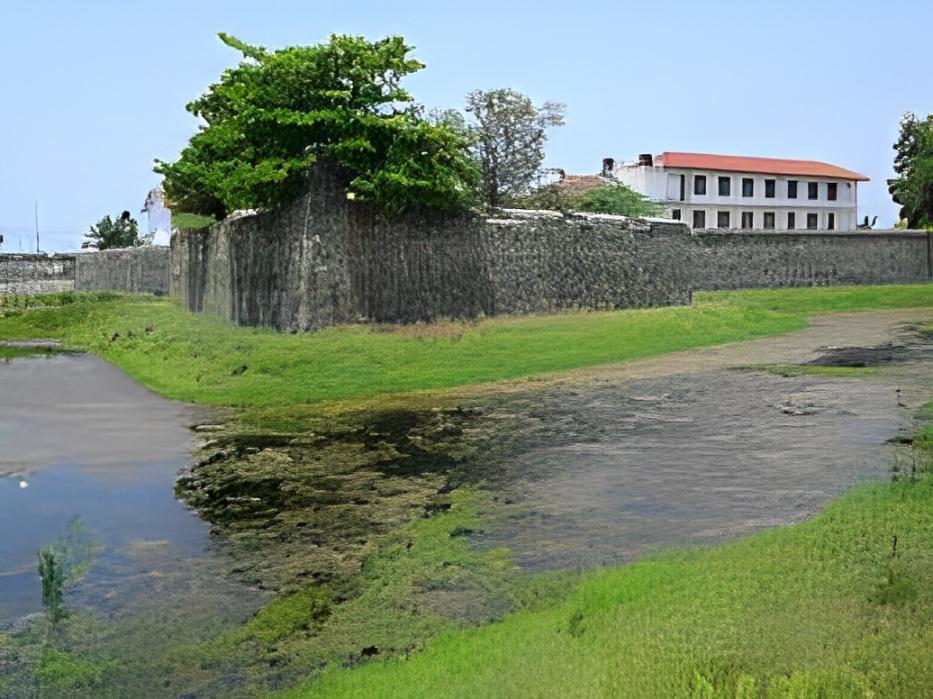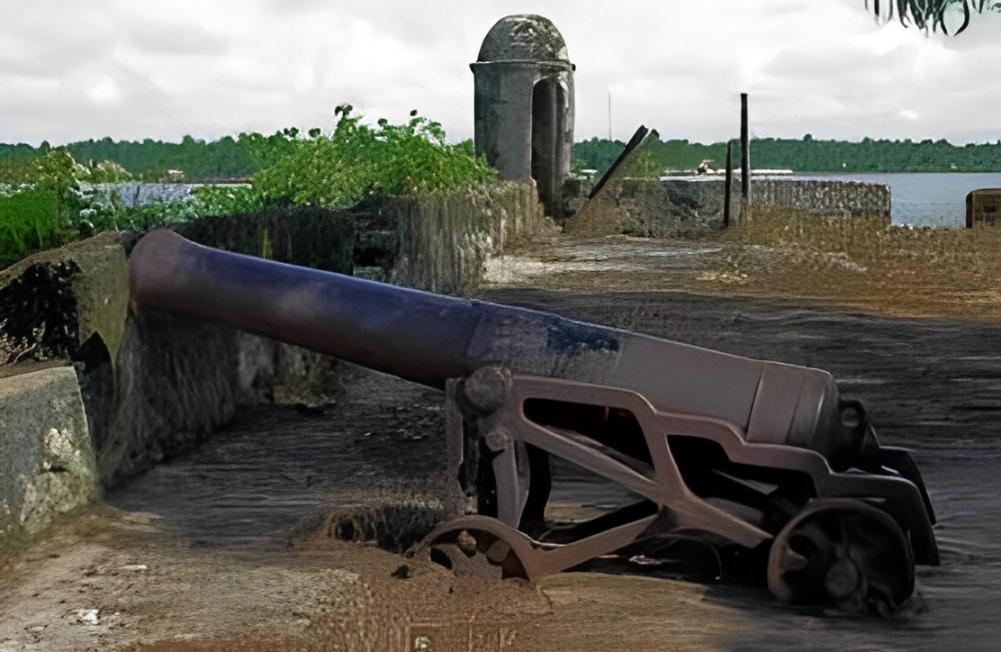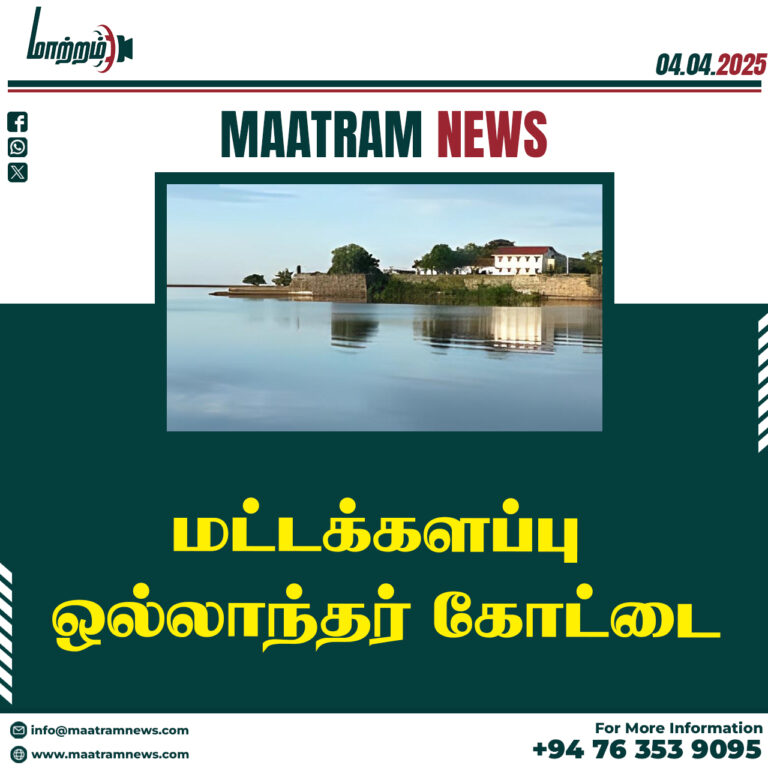இலங்கையின் கிழக்கு மாகாணத்தில் அமைந்துள்ள மட்டக்களப்பு ஒல்லாந்தர் கோட்டை , தீவின் வளமான காலனித்துவ வரலாற்றுக்கும் அதன் மூலங்களுக்கும் சான்றாக விளங்குகிறது. 17ஆம் நூற்றாண்டின் ஆரம்பத்தில் கட்டப்பட்ட இந்த கோட்டை, போர்த்துக்கேயர், ஒல்லாந்தர் மற்றும் பிரித்தானியர் ஆகிய பல காலனித் தலைமுறைகளின் ஆட்சி மாற்றங்களை சந்தித்துள்ளது.
வரலாற்றுப் பின்னணி
போர்த்துக்கேயர்கள் 17ஆம் நூற்றாண்டின் ஆரம்பத்தில் இலங்கையில் தங்கள் ஆட்சியை நிறுவியபோது, பாதுகாப்பிற்காக சிறிய ஒரு கோட்டையை மட்டக்களப்பில் கட்டினர். கடல் மற்றும் ஏரி அருகே அமைந்த இந்த இடம், புவியியல் ரீதியாக முக்கியத்துவம் வாய்ந்ததாக இருந்ததால், அவர்கள் இங்கு தங்களுடைய அதிகாரத்தை நிலைநிறுத்த முயன்றனர்.
இலங்கையின் வாசனைத் திரவிய வர்த்தகத்தை தங்களின் கட்டுப்பாட்டில் கொண்டு வர ஒல்லாந்தர் , போர்த்துக்கேயர்களுடன் பல போர்களை நடாத்தினர். இறுதியில் 1628ஆம் ஆண்டு ஒல்லாந்தர் கோட்டையை கைப்பற்றி, அதை புதிய பாதுகாப்பு கட்டமைப்புடன் மறுபடியும் நிர்மாணித்தனர்.
மட்டக்களப்பு ஒல்லாந்தர் கோட்டை முதன்மையாக சுண்ணாம்பு கல் மற்றும் பவளக்கல் பயன்படுத்தி கட்டப்பட்டது. இவை இப்பகுதியில் எளிதாக கிடைக்கும் பொருட்கள். மற்றைய கோட்டைகளைப் போலல்லாமல், இது மட்டக்களப்புக் கடல் நீரோடைக்கு அருகில் மூலோபாய ரீதியாகக் கட்டப்பட்டது. இது கப்பல்களில் பிரயாணம் செய்பவர்களுக்கு இலகுவாக அமைந்தது வர்த்தகம் மற்றும் இராணுவ நடவடிக்கைகளை எளிதாக்கியது. ஒல்லாந்தர் ஒரு நூற்றாண்டுக்கும் மேலாக இப்பகுதியை ஆட்சி செய்ய கோட்டையை ஒரு முக்கிய நிர்வாக மையமாகப் பயன்படுத்தினர்.
1796 ஆம் ஆண்டில், ஆங்கிலேயர்கள் இலங்கையை ஒல்லாந்தரிடமிருந்து கைப்பற்றினர், இது தீவின் காலனித்துவ வரலாற்றில் ஒரு புதிய சகாப்தத்தைக் குறித்தது. முதன்மையாக இராணுவத் தளமாகச் செயல்பட்ட இந்தக் கோட்டை, பிரித்தானியர் ஆட்சியின் கீழ் ஒரு நிர்வாக மையமாக மாறியது. ஆங்கிலேயர்கள் அதன் கட்டமைப்பை கணிசமாக மாற்றியமைக்கவில்லை என்றாலும், அவர்கள் கோட்டையை ஆட்சி மற்றும் சட்ட அமுலாக்க நோக்கங்களுக்காகப் பயன்படுத்தினர்.
மட்டக்களப்பு ஒல்லாந்தர் கோட்டை நான்கு கோட்டைகளைக் கொண்ட சதுர வடிவ கோட்டையாகும். எதிரிகளின் தாக்குதல்களிலிருந்து பாதுகாக்க ஒவ்வொரு கோட்டையிலும் பீரங்கி பொருத்தப்பட்டிருந்தது. பவளப்பாறைகள் மற்றும் கற்களால் கட்டப்பட்ட கோட்டையின் தடிமனான சுவர்கள், பல நூற்றாண்டுகளாக இயற்கை சீற்றங்களுக்கு உள்ளாகியிருந்தாலும் அமைப்பு மாறாமல் குறிப்பிடத்தக்க வகையில் அப்படியே உள்ளன.
முக்கிய கட்டிடக்கலை அம்சங்கள்:
- தடிமனான சுவர்கள் நிலம் மற்றும் கடல் இரண்டிலிருந்தும் எதிரிகளின் தாக்குதல்களைத் தாங்கும் வகையில் வடிவமைக்கப்பட்டுள்ளது
- இந்த கோட்டையில் ஒரு காலத்தில் இராணுவ முகாம்கள் மற்றும் நிர்வாக அலுவலகங்கள் இருந்தன.
- வளைந்த நுழைவாயில்கள்: டச்சு பொறியியல் மற்றும் வடிவமைப்பைக் காட்டுகிறது.
- காவற்கோபுரங்கள்: எதிரிகளின் நடமாட்டத்தைக் கண்காணிப்பதற்காக அமைக்கப்பட்டு இருந்தது

நவீன காலத்தில் ஏற்பட்டுள்ள மாற்றம்
சுற்றுலா ஈர்ப்பு
இன்று, மட்டக்களப்பு ஒல்லாந்தர் கோட்டை நன்கு பாதுகாக்கப்பட்ட வரலாற்று தளமாகவும், பிரபலமான சுற்றுலா தளமாகவும் உள்ளது. பார்வையாளர்கள் அதன் பழங்கால சுவர்களை பார்வையிடலாம், உள் முற்றத்தை பார்க்கலாம் மற்றும் மட்டக்களப்பு வாவியின் பரந்த காட்சிகளை ரசிக்கலாம். கோட்டையின் சுற்றுப்புறங்கள் இயற்கை எழில் கொஞ்சும், பசுமையான சூழல் மற்றும் நீர்வழிகள் ஆகியவற்றின் அழகை ரசிக்கலாம் .
நிர்வாக அலுவலகங்கள்
வரலாற்று நினைவுச்சின்னமாக இருந்தபோதிலும், கோட்டை இன்னும் பயன்பாட்டில் உள்ளது. காணி மற்றும் நிர்வாகம் தொடர்பான பல அரச அலுவலகங்கள் அதன் எல்லைக்குள் இன்றும் அமைந்துள்ளன.
மட்டக்களப்பு ஒல்லாந்தர் கோட்டை பற்றிய சுவாரஸ்யமான தகவல்கள்
இலங்கையின் கிழக்கு மாகாணத்தில் உள்ள மிகப் பழமையான ஒல்லாந்தர் கோட்டை: தீவின் கிழக்குப் பகுதியில் ஒல்லாந்தரால் கட்டப்பட்ட சில எஞ்சியிருக்கும் கோட்டைகளில் முக்கியமான ஒன்றாக இன்றும் கருதப்படுகிறது
பல நூற்றாண்டுகளாக, காலனித்துவ சக்திகளுக்கு இடையிலான இராணுவ மோதல்களின் மையத்தில் இது காணப்படுவதால் பல போர்களைக் கண்டது .
இக்கோடடையின் அருகில் அமைந்திருக்கும் மட்டுவாவி உள்ளூர்வாசிகளால் “பாடும் மீன்” என்று விவரிக்கும் மர்மமான ஒலிகளுக்கு பிரபலமானது.
மட்டக்களப்பு ஒல்லாந்தர் கோட்டை வெறும் ஒரு பழங்காலக் கட்டமைப்பை விட முக்கியமானதொன்றாகும். இது காலனித்துவ வெற்றிகள், மூலோபாய இராணுவத் திட்டமிடல் மற்றும் கட்டிடக்கலை புத்திசாலித்தனம் ஆகியவற்றின் கதையைச் சொல்கிறது. நீங்கள் ஒரு வரலாற்று ஆர்வலராக இருந்தாலும் சரி, கட்டிடக்கலை ஆர்வலராக இருந்தாலும் சரி, அல்லது இலங்கையை ஆராயும் சுற்றுலா பயணியாக இருந்தாலும் சரி, இந்தக் கோட்டையைப் பார்வையிடுவது கடந்த காலத்தைப் பற்றிய தெளிவை வழங்குவதோடு இனம் புரியாத வியப்பையும் ஏற்படுத்தும் என்பதில் ஐயமில்லை ஒரு தடவை பார்வையிட்டுதான் பாருங்களேன்.
மேலதிக தகவல்களுக்கு மாற்றம் செய்திகள்
Batticaloa Dutch Fort
Nestled in the eastern coast of Sri Lanka, the Batticaloa Dutch Fort stands as a testament to the island’s rich colonial past and strategic importance. Built in the early 17th century, this well-preserved fort has witnessed the rule of multiple colonial powers, including the Portuguese, Dutch, and British. Today, it remains a significant historical monument, attracting both tourists and history enthusiasts eager to explore its storied past, architectural grandeur, and cultural legacy.

Historical Background
Portuguese Origins
The history of the Batticaloa Fort dates back to the early 17th century when the Portuguese, who had established a strong presence in Sri Lanka, sought to fortify their territories. They built a small defensive structure in Batticaloa, recognizing its strategic location near the lagoon and the Indian Ocean. However, their control was short-lived due to increasing Dutch naval power.
Dutch Takeover and Fort Construction (1628)
The Dutch, seeking to expand their control over Sri Lanka and establish dominance over the lucrative spice trade, launched a military campaign against the Portuguese. In 1628, the Dutch successfully captured the fort and decided to rebuild it with stronger defenses.
The Batticaloa Dutch Fort was constructed with coral and limestone, materials readily available in the region. Unlike many other forts, it was strategically built near the Batticaloa Lagoon, allowing easy access for ships and facilitating trade and military operations. The Dutch ruled the region for over a century, using the fort as a key administrative center.
British Rule and the Changing Role of the Fort
In 1796, the British took control of Sri Lanka from the Dutch, marking a new era in the island’s colonial history. The fort, which had primarily served as a military base, transitioned into an administrative center under British rule. Though the British did not significantly modify its structure, they utilized the fort for governance and law enforcement purposes.
Architectural Significance
The Batticaloa Dutch Fort is a square-shaped fortification with four bastions. Each bastion was equipped with cannons to defend against enemy attacks. The fort’s thick walls, constructed from coral and stone, remain remarkably intact despite centuries of exposure to the elements.
Key Architectural Features:
- Thick Walls and Bastions: Designed to withstand attacks from both land and sea.
- Inner Courtyard: Once housed military barracks and administrative offices.
- Arched Entrances: Showcases Dutch engineering and design.
- Watchtowers: Provided vantage points for monitoring enemy movements.
The fort’s location near the Batticaloa Lagoon added to its defensive advantage, making it difficult for enemy ships to launch direct assaults.
Batticaloa Dutch Fort in Modern Times
Tourist Attraction
Today, the Batticaloa Dutch Fort is a well-preserved historical site and a popular tourist destination. Visitors can walk along its ancient walls, explore the inner courtyard, and take in panoramic views of the Batticaloa Lagoon. The fort’s surroundings are scenic, with lush greenery and waterways adding to its charm.
Administrative Offices
Despite being a historical monument, the fort is still in use. Several government offices, including those related to land and governance, are housed within its walls. This dual-purpose use highlights the fort’s continuing relevance in the modern era.
Cultural and Heritage Value
The fort is not just a relic of colonial history but also an important part of Sri Lankan heritage. It serves as a reminder of the country’s complex past, showcasing the influences of Portuguese, Dutch, and British rule.

Interesting Facts About the Batticaloa Dutch Fort
- Oldest Dutch Fort on Sri Lanka’s East Coast: It is one of the few surviving forts built by the Dutch in the eastern part of the island.
- Strategic Location: Built near the lagoon to facilitate trade and defense.
- Witnessed Several Battles: Over the centuries, it has been at the center of military conflicts between colonial powers.
- Still in Use: Unlike many other forts that have turned into museums, the Batticaloa Fort continues to function as an administrative hub.
- Near the ‘Singing Fish’ Lagoon: The nearby lagoon is famous for mysterious sounds that locals describe as “singing fish.
The Batticaloa Dutch Fort is more than just an ancient structure; it is a living piece of Sri Lankan history. It tells the story of colonial conquests, strategic military planning, and architectural brilliance. Whether you are a history buff, an architecture enthusiast, or a traveler exploring Sri Lanka, a visit to this fort offers a fascinating glimpse into the past.
For more articles visit us Maatram News



